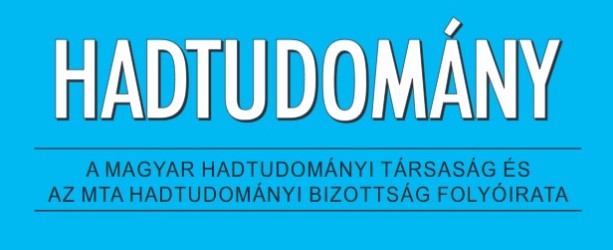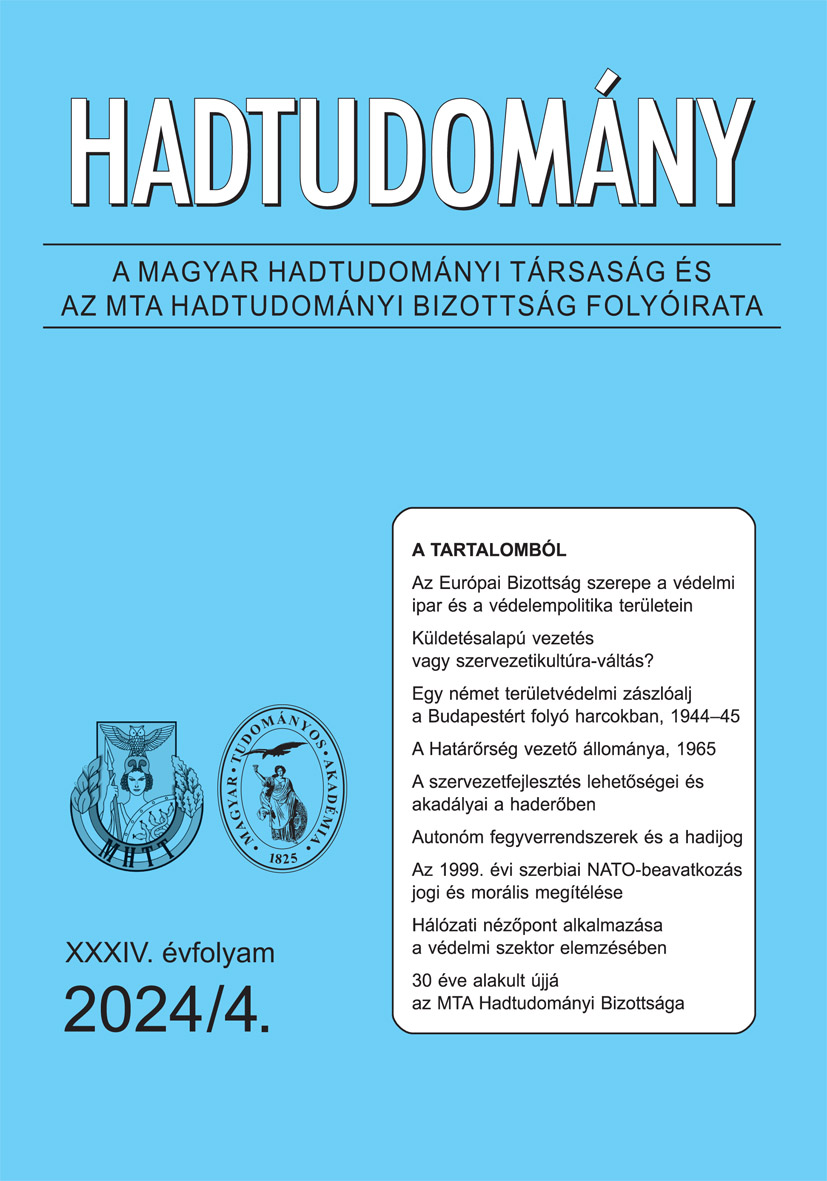A hálózati nézőpont alkalmazásának megfelelősége a gazdaságpolitikai döntésekben a védelmi ipar esetében
Absztrakt
A közgazdaságtani irányzatok között hosszú idő óta megoszlanak a vélemények, hogy az államnak milyen mértékig szükséges (vagy szabad) beleavatkozni a piaci, gazdasági folyamatokba. A megengedhető mérték nagysága egyben kijelöli az állam gazdasági szerepének határait és kereteit. E munka következtetése, hogy a hálózati nézőpont alkalmazásával jól modellezhetőek az állam feladatai a gazdaságpolitika egyes kérdéseinek és a gazdaság területeinek – mint például a védelmi szektor – elemzésénél.
Hivatkozások
Acosta, Manuel; Coronado, Daniel; Marín, Rosario 2011. Potential Dual-Use of Military Technology: Does Citing Patents Shed Light on This Process? Defence and Peace Economics 22 (3): 335–349. https://doi.org/10.1080/10242694.2010.491681
Balogh Péter 2022. Patterns of Cooperation in the European Defence Sector – A Network-Approach-Based Investigation of EU Projects. Acta Univ. Sapientiae, European and Regional Studies, 22: 34–49. https://doi.org/10.2478/auseur-2022-0008
Barabási Albert-László 2022. Behálózva. A hálózatok új tudománya. Budapest: Open Books.
Benczes István; Kutasi Gábor 2010. Költségvetési pénzügyek. Budapest: Akadémiai Kiadó.
Bitzinger, Richard A. 2015. New ways of thinking about the global arms industry Dealing with ‘limited autarky’. Strategic Insights, ASPI, Australian Strategic Policy Institute https://www.aspi.org.au/report/new-ways-thinking-about-global-arms-industry-dealing-limited-autarky (Letöltve 2025. 01. 19.)
Boulanin, Vincent 2016. Mapping the innovation ecosystem driving the advance of autonomy in weapon systems. Working paper, Stockholm International Peace Research Institute https://www.sipri.org/sites/default/files/Mapping-innovation-ecosystem-driving-autonomy -in-weapon-systems.pdf (Letöltve 2025. 01. 19.)
Budavári Krisztina; Taksás Balázs; Hegedûs Ernő 2022. A magyar védelmi ipar innovációs környezetének vizsgálata. Hadtudomány, 32 (1): 113–134. https://doi.org/10.17047/HADTUD.2022.32.1.113
Calcara, Antonio 2020. Cooperation and non cooperation in European defence procurement. Journal of European Integration, 42 (6): 799–815. https://doi.org/10.1080/07036337.2019.1682567
Callado-Muñoz, Francisco J.; Fernández-Olmos, Marta; Ramírez-Alesón, Marisa; Utrero-González, Natalia 2022. Characterisation of Technological Collaborations and Evolution in the Spanish Defence Industry. Defence and Peace Economics, 33 (2): 219–238. https://doi.org/10.1080/10242694.2020.1799168
Coetzee, Wayne S. – Berndtsson, Joakim 2023. Understanding Sweden’s security economy. Defense & Security Analysis, 39 (2): 171-190. https://doi.org/10.1080/14751798.2023.2182479 Dinya László 2008. Szervezetek sikere és válsága. Budapest: Akadémiai Kiadó.
Dunne, J. Paul; Smith, Ron P.; Willenbockel, Dirk 2005. Models of Military Expanditure and Growth: A critical Review. Defence and Peace Economics, 16 (6): 449–461. https://doi.org/10.1080/10242690500167791
Dunne, J. Paul; Tian, Nan 2013. Military expenditure and economic growth: A survey. The Economics of Peace and Security Journal, 8 (1): 5–11. http://dx.doi.org/10.15355/epsj.8.1.5
Eliasson, Gunnar 2017. Visible costs and invisible benefits. Military procurement as innovation policy. Cham: Springer International Publishing AG.
Eliasson, Gunnar 2010. Advanced Public Procurement as Industrial Policy. The Aircraft Industry as a Technical University. New York: Springer Science+Business Media, LLC.
Etzkowitz, Henry: Innovation in Innovation: The Triple Helix of University – Industry - Government Relations. Social Science Information, 42 (3): 293–337. https://doi.org/10.1177/05390184030423002
Etzkowitz, Henry 2008. The Triple Helix. University–Industry–Government Innovation in Action. Taylor & Francis e-Library.
Farkas Beáta 2022. A közgazdasági gondolkodás rövid története. Budapest: Akadémiai Kiadó.
Gelei Andrea 2009. Hálózat – A globális gazdaság kvázi szervezete. Vezetéstudomány, 40 (1): 16–33. http://dx.doi.org/10.14267/VEZTUD.2009.01.02
Giacomello, Giampiero; Preka, Oltion 2023. Sources of strength: mapping the defence sector in Europe.
Defence Studies, 23 (4): 531–560. https://doi.org/10.1080/14702436.2023.2277436
Håkansson, Håkan 2010. Üzleti kapcsolatok és hálózatok: gazdaságpolitikai következtetések. In Håkansson, Håkan: Határtalan hálózatok. Budapest: Alinea Kiadó.
Harrison, Debbie; Håkansson, Håkan 2010. Hogyan mobilizáljuk az erőforrás-hálózatokat – légi és vízi kikötők összehasonlító elemzése. In Håkansson, Håkan: Határtalan hálózatok. Budapest: Alinea Kiadó.
Hartley, Keith 2006. Defence R&D: Data Issues. Defence and Peace Economics, 17 (3): 169–175. https://doi.org/10.1080/10242690600645027
Hayward, Keith 2001. The globalisation of defence industries. Survival, 43 (2): 115–132. https://doi.org/10.1093/survival/43.2.115
Lengyel Imre 2021. Regionális és városgazdaságtan. Szegedi Egyetemi Kiadó, Szeged.
Köves Alexandra; Mandják Tibor 2014. Úton egy fenntartható gazdasági paradigma felé – A komplexitás befogadása a hálózati elméleteken keresztül (Towards a sustainable economic paradigm – Acceptance of the complexity through network theories). Vezetéstudomány - Budapest Management Review, 45 (7–8): 69–75. https://unipub.lib.uni-corvinus.hu/1713/#:~:text=DOI%2010.14267/VEZTUD.2014.07.06
KSH 21.1.1.18. A kormányzat végső fogyasztási kiadása funkciók szerint [millió Ft] https://www.ksh.hu/stadat_files/gdp/hu/gdp0018.html (Letöltve 2025. 01. 19.)
Kurç, Çaðlar; G. Neuman, Stephanie G. 2017. Defence industries in the 21st century: a comparative analysis, Defence Studies, 17 (3): 219–227. https://doi.org/10.1080/14702436.2017.1350105
Mandják Tibor; Wimmer Ágnes; Juhász Péter 2012. A hálózati pozíció és a versenyképesség kapcsolata. (Business networks: network position and competitiveness in Hungary). Vezetéstudomány - Budapest Management Review, 42 (2): 14–23. http://dx.doi.org/10.14267/VEZTUD.2012.ksz2.02
Pesti István 2024. Védelmi ipari innovációs ökoszisztémák. Honvédségi Szemle – Hungarian Defence Review, 152 (3): 126–141. https://doi.org/10.35926/HSZ.2024.3.10
Riebe, Thea; Schmid, Stefka; Reuter, Christian 2021. Measuring Spillover Effects from Defense to Civilian Sectors –A Quantitative Approach Using LinkedIn. Defence and Peace Economics, 32 (7): 773–785. https://doi.org/10.1080/10242694.2020.1755787
Schmid, Jon 2018. The Diffusion of Military Technology. Defence and Peace Economics, 29 (6): 595–613. https://doi.org/10.1080/10242694.2017.1292203
Sempere, Carlos Martí 2018. What Is Known About Defence Research And Development Spill-Overs? Defence and Peace Economics, 29 (3): 225–246. https://doi.org/10.1080/10242694.2016.1239364
SIPRI Fact Sheet April 2024. Trend in world military expenditure, 2023 https://www.sipri.org/sites/default/files/2024-04/2404_fs_milex_2023.pdf (Letöltve: 2024. 05. 20.)
Szenes Zoltán 2022. A hadifinanszírozás napjainkban (1990–2020) In: Pósán, László; Veszprémy, László; Isaszegi, János (szerk.) A hadifinanszírozás gazdasági alapjai az ókortól napjainkig. Budapest: Zrínyi Kiadó.
Thadakamaila, Hari Prasad; Raghavan, Usha Nandini; Kumara, Soundar; Albert Réka 2004. Survivability of multiagent-based supply networks: a topological perspect. IEEE Intelligent Systems, 19 (5): 24–31. https://doi.org/10.1109/MIS.2004.49
The Defence Transfer Directive. Handbook for SMEs. European Union, 2021 https://defence-industry-space.ec.europa.eu/eu-defence-industry/defence-smes/defence-transfers-directive-handbook-smes_en (letöltve: 2024. 03. 24) Tirole, Jean 2021. Közgazdaságtan a közjóért. Budapest: Osiris Kiadó.
Vigvári András 2015. Pénzügy(rendszer)tan. Budapest: Akadémiai Kiadó.
Voszka Éva 2019. Iparpolitika határok nélkül = Industrial Policy Without Borders. Külgazdaság: A Kopint Konjuktúra Kutatási Alapítvány Folyóirata, 63 (1–2): 82–115. https://doi.org/10.47630/KULG.2019.63.1-2.82
Wiœniewski, Rafa³ 2012. Defence Industry in the European Union – Challenges and Opportunities in Times of Economic Crisis. Przegl¹d Strategiczny, (2): 95–113. https://doi.org/10.14746/ps.2012.2.8
Yildirim, Jülide; Sezgin, Selami; Öcal, Nadir 2005. Military Expenditure and Economic Growth in Middle Eastern Countries: A Dynamic Panel Data Analysis. Defence and Peace Economics 16 (4): 283–295. https://doi.org/10.1080/10242690500114751
Yildirim, Jülide; Öcal, Nadir 2016. Military Expenditure, Economic Growth and spatial spillovers. Defence and Peace Economics, 27 (1): 87–104. https://doi.org/10.1080/10242694.2014.960246
Zhang, Ying; Wang, Rui; Yao, Dongqi 2017. Does defence expenditure have a spillover effect on income inequality? A cross-regional analysis in China. Defence and Peace Economics, 28 (6): 731–749. https://doi.org/10.1080/10242694.2016.1245812




